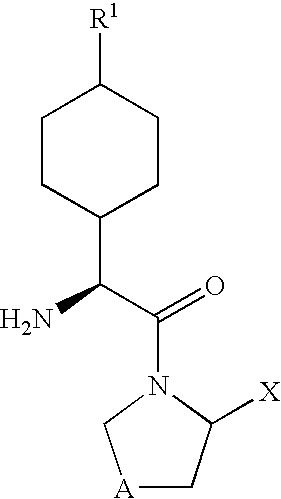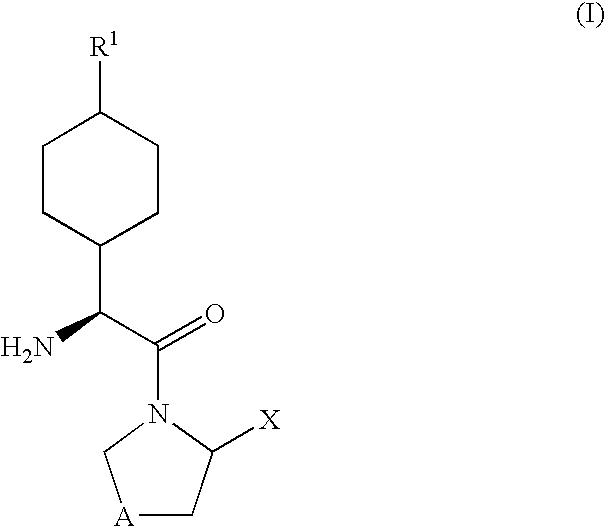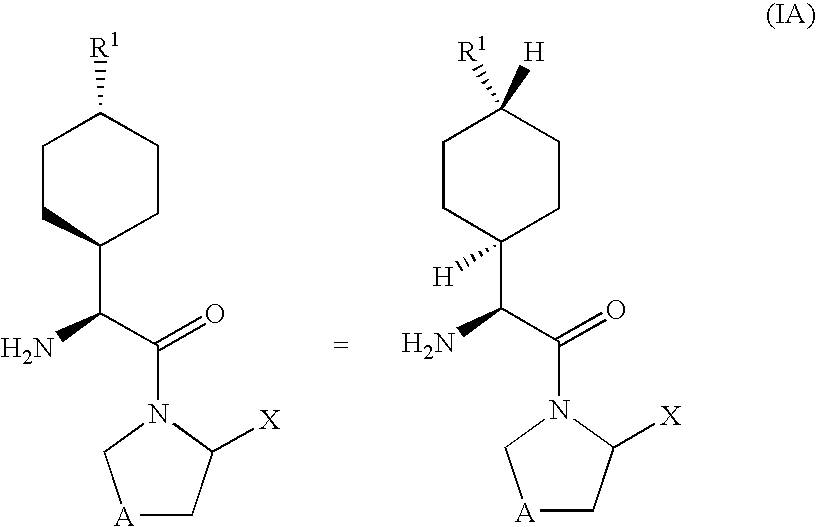Dipeptidyl peptidase-IV inhibitors
a technology of peptidase and inhibitor, which is applied in the direction of biocide, drug composition, metabolic disorder, etc., can solve the problems of limiting the use the treatment of diabetes remains less than satisfactory, and the side effects of clinically available hypoglycemic drugs, etc., to achieve the effect of improving gastrointestinal permeability, equal or better dpp-iv inhibitory activity
- Summary
- Abstract
- Description
- Claims
- Application Information
AI Technical Summary
Benefits of technology
Problems solved by technology
Method used
Image
Examples
examples 1-7
[0150] The compounds of Examples 1-7 were prepared using (S)-[1-(cis-4-amino-cyclohexyl)-2-oxo-2-pyrrolidin-1-yl-ethyl]-carbamic acid tert-butyl ester, shown below, which was synthesized as follows.
Step 1: (S)-tert-Butoxycarbonylamino-(trans-4-hydroxy-cyclohexyl)-acetic acid
[0151] A mixture of 4-hydroxy-L-phenylglycine (15 g, 90 mmol) and Raney Nickel (30 g) in 3 N sodium hydroxide (30 mL) and water (220 mL) was hydrogenated at 40 psi and 55° C. overnight. The mixture was cooled to room temperature and filtered over diatomaceous earth, then concentrated to about half its volume. The solution was diluted with water (180 mL) and dioxane (120 mL) and treated with triethylamine (22.6 mL, 162 mmol) and di-tert-butyl dicarbonate (23.6 g, 108 mmol). The reaction mixture was concentrated to about half its volume, cooled to 0° C., acidified to pH 2-3 with 10% potassium bisulfate then extracted with ethyl acetate (3×). The combined extracts were washed with brine, dried over magnesium sulf...
example 1
[0155] The hydrochloride salt of N-{[cis-4-((1S)-1-amino-2-oxo-2-pyrrolidin-1-yl-ethyl)-cyclohexylcarbamoyl]-methyl}-benzamide, shown below, was prepared as follows.
Step 1: (S)-{1-[trans-4-(2-Benzoylamino-acetylamino)-cyclohexyl]-2-oxo-2-pyrrolidin-1-yl-ethyl}-carbamic acid tert-butyl ester
[0156] 1-(3-Dimethylaminopropyl)-3-ethylcarbodiimide hydrochloride (71 mg, 0.37 mmol) was added to a solution of [(S)-1-(cis-4-amino-cyclohexyl)-2-oxo-2-pyrrolidin-1-yl-ethyl]-carbamic acid tert-butyl ester, (100 mg, 0.31 mmol), hippuric acid (66 mg, 0.37 mmol) and hydroxybenzotriazole (50 mg, 0.37 mmol) in dichloromethane (5 mL). The mixture was stirred overnight at room temperature, then concentrated and the residue was diluted with ethyl acetate, washed with 2 N sodium hydroxide, water and brine, dried over magnesium sulfate and concentrated. The residue was purified by flash-chromatography (ethyl acetate) and the product was obtained as a white solid (39 mg, 26%).
Step 2: N-{[cis-4-((1S)-1-...
example 2
[0158] The hydrochloride salt of {[cis-4-((1S)-1-amino-2-oxo-2-pyrrolidin-1-yl-ethyl)-cyclohexylcarbamoyl]-methyl}-carbamic acid benzyl ester, shown below, was prepared by the method of Example 1 using (S)-[1-(cis-4-amino-cyclohexyl)-2-oxo-2-pyrrolidin-1-yl-ethyl]-carbamic acid tert-butyl ester and carbobenzyloxy-glycine. MS m / z 417 (MH+).
PUM
 Login to View More
Login to View More Abstract
Description
Claims
Application Information
 Login to View More
Login to View More - R&D
- Intellectual Property
- Life Sciences
- Materials
- Tech Scout
- Unparalleled Data Quality
- Higher Quality Content
- 60% Fewer Hallucinations
Browse by: Latest US Patents, China's latest patents, Technical Efficacy Thesaurus, Application Domain, Technology Topic, Popular Technical Reports.
© 2025 PatSnap. All rights reserved.Legal|Privacy policy|Modern Slavery Act Transparency Statement|Sitemap|About US| Contact US: help@patsnap.com



